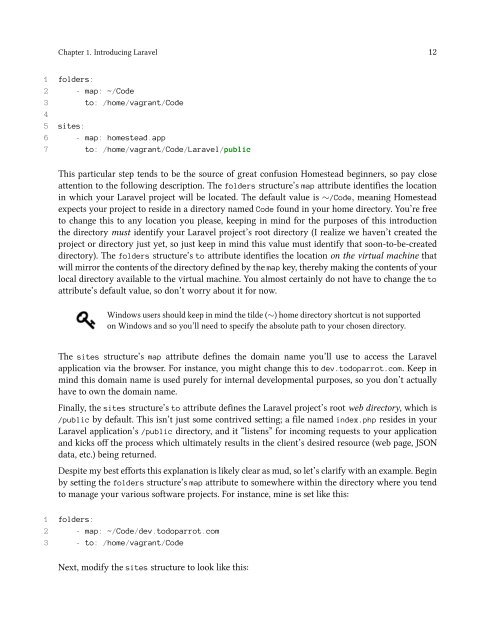easylaravel-sample
You also want an ePaper? Increase the reach of your titles
YUMPU automatically turns print PDFs into web optimized ePapers that Google loves.
Chapter 1. Introducing Laravel 12<br />
1 folders:<br />
2 - map: ~/Code<br />
3 to: /home/vagrant/Code<br />
4<br />
5 sites:<br />
6 - map: homestead.app<br />
7 to: /home/vagrant/Code/Laravel/public<br />
This particular step tends to be the source of great confusion Homestead beginners, so pay close<br />
attention to the following description. The folders structure’s map attribute identifies the location<br />
in which your Laravel project will be located. The default value is ∼/Code, meaning Homestead<br />
expects your project to reside in a directory named Code found in your home directory. You’re free<br />
to change this to any location you please, keeping in mind for the purposes of this introduction<br />
the directory must identify your Laravel project’s root directory (I realize we haven’t created the<br />
project or directory just yet, so just keep in mind this value must identify that soon-to-be-created<br />
directory). The folders structure’s to attribute identifies the location on the virtual machine that<br />
will mirror the contents of the directory defined by the map key, thereby making the contents of your<br />
local directory available to the virtual machine. You almost certainly do not have to change the to<br />
attribute’s default value, so don’t worry about it for now.<br />
Windows users should keep in mind the tilde (∼) home directory shortcut is not supported<br />
on Windows and so you’ll need to specify the absolute path to your chosen directory.<br />
The sites structure’s map attribute defines the domain name you’ll use to access the Laravel<br />
application via the browser. For instance, you might change this to dev.todoparrot.com. Keep in<br />
mind this domain name is used purely for internal developmental purposes, so you don’t actually<br />
have to own the domain name.<br />
Finally, the sites structure’s to attribute defines the Laravel project’s root web directory, which is<br />
/public by default. This isn’t just some contrived setting; a file named index.php resides in your<br />
Laravel application’s /public directory, and it “listens” for incoming requests to your application<br />
and kicks off the process which ultimately results in the client’s desired resource (web page, JSON<br />
data, etc.) being returned.<br />
Despite my best efforts this explanation is likely clear as mud, so let’s clarify with an example. Begin<br />
by setting the folders structure’s map attribute to somewhere within the directory where you tend<br />
to manage your various software projects. For instance, mine is set like this:<br />
1 folders:<br />
2 - map: ~/Code/dev.todoparrot.com<br />
3 - to: /home/vagrant/Code<br />
Next, modify the sites structure to look like this:



